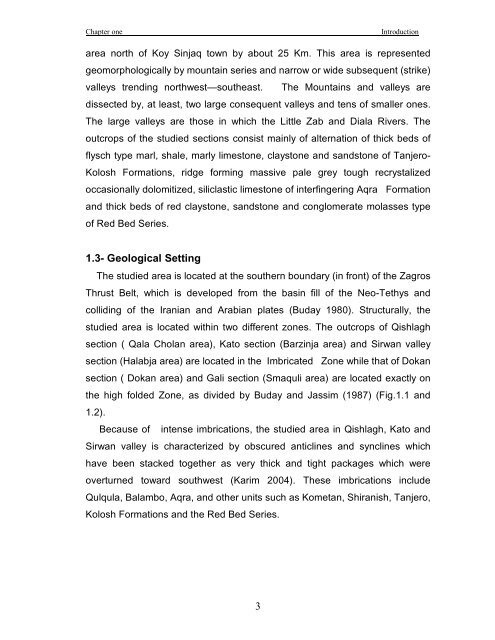biostratigraphy and paleoecology of cretaceous/tertiary boundary in ...
biostratigraphy and paleoecology of cretaceous/tertiary boundary in ...
biostratigraphy and paleoecology of cretaceous/tertiary boundary in ...
Create successful ePaper yourself
Turn your PDF publications into a flip-book with our unique Google optimized e-Paper software.
Chapter one<br />
Introduction<br />
area north <strong>of</strong> Koy S<strong>in</strong>jaq town by about 25 Km. This area is represented<br />
geomorphologically by mounta<strong>in</strong> series <strong>and</strong> narrow or wide subsequent (strike)<br />
valleys trend<strong>in</strong>g northwest—southeast. The Mounta<strong>in</strong>s <strong>and</strong> valleys are<br />
dissected by, at least, two large consequent valleys <strong>and</strong> tens <strong>of</strong> smaller ones.<br />
The large valleys are those <strong>in</strong> which the Little Zab <strong>and</strong> Diala Rivers. The<br />
outcrops <strong>of</strong> the studied sections consist ma<strong>in</strong>ly <strong>of</strong> alternation <strong>of</strong> thick beds <strong>of</strong><br />
flysch type marl, shale, marly limestone, claystone <strong>and</strong> s<strong>and</strong>stone <strong>of</strong> Tanjero-<br />
Kolosh Formations, ridge form<strong>in</strong>g massive pale grey tough recrystalized<br />
occasionally dolomitized, siliclastic limestone <strong>of</strong> <strong>in</strong>terf<strong>in</strong>ger<strong>in</strong>g Aqra Formation<br />
<strong>and</strong> thick beds <strong>of</strong> red claystone, s<strong>and</strong>stone <strong>and</strong> conglomerate molasses type<br />
<strong>of</strong> Red Bed Series.<br />
1.3- Geological Sett<strong>in</strong>g<br />
The studied area is located at the southern <strong>boundary</strong> (<strong>in</strong> front) <strong>of</strong> the Zagros<br />
Thrust Belt, which is developed from the bas<strong>in</strong> fill <strong>of</strong> the Neo-Tethys <strong>and</strong><br />
collid<strong>in</strong>g <strong>of</strong> the Iranian <strong>and</strong> Arabian plates (Buday 1980). Structurally, the<br />
studied area is located with<strong>in</strong> two different zones. The outcrops <strong>of</strong> Qishlagh<br />
section ( Qala Cholan area), Kato section (Barz<strong>in</strong>ja area) <strong>and</strong> Sirwan valley<br />
section (Halabja area) are located <strong>in</strong> the Imbricated Zone while that <strong>of</strong> Dokan<br />
section ( Dokan area) <strong>and</strong> Gali section (Smaquli area) are located exactly on<br />
the high folded Zone, as divided by Buday <strong>and</strong> Jassim (1987) (Fig.1.1 <strong>and</strong><br />
1.2).<br />
Because <strong>of</strong> <strong>in</strong>tense imbrications, the studied area <strong>in</strong> Qishlagh, Kato <strong>and</strong><br />
Sirwan valley is characterized by obscured anticl<strong>in</strong>es <strong>and</strong> syncl<strong>in</strong>es which<br />
have been stacked together as very thick <strong>and</strong> tight packages which were<br />
overturned toward southwest (Karim 2004). These imbrications <strong>in</strong>clude<br />
Qulqula, Balambo, Aqra, <strong>and</strong> other units such as Kometan, Shiranish, Tanjero,<br />
Kolosh Formations <strong>and</strong> the Red Bed Series.<br />
3

















